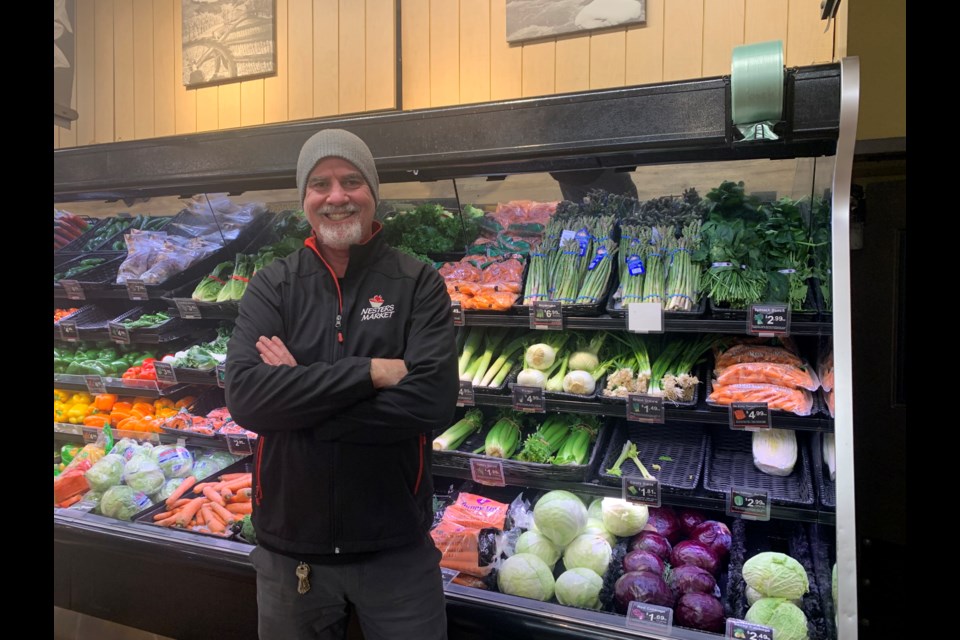There we were, three of us, baffled, searching up and down the baking supplies aisle in my mom’s neighbourhood Save-On—a big store, a very big store—scrutinizing the shelves, high and low, and way off track in the nuts and dried fruits section, even the cereal zone.
We couldn’t find any cornstarch—you know, the thickening agent you can use to add structure to sauces, stews, baked goods, fruit compotes, you name it.
In fact, we couldn’t even find a telltale spot on the shelf for it with the product name and price on a little shelf tag, the all-time give-away that the store does carry it, but the truck just got stuck in an A., road wash-out; B., snowstorm; or C., fill in the latest B.C. extreme weather event. That, or there were other supply-chain issues, so they’re temporarily out of stock. (In the grocery biz that’s known as an OOS: “out of stock.”) But not even a hole on the shelf for it? That seemed pretty weird.
No cornstarch. No cornstarch OOS. Not in the baking supplies aisle; not in the bulk section; not in the organic department, although they did have potato starch. But mom nixed that. (More on potato starch later.)
As for our intrepid search—we’ve gotten used to such searches in these unusual times—even other customers, who were helping us as earnestly as if we were all on a reality game show, were puzzled there was no trace of such a basic product. Finally, a manager confirmed our suspicions: No cornstarch, and he didn’t know when there would be any.
So goes the world of grocery shopping these days, approaching our third year of the pandemic. After we all got over yeast and flour shortages in the early days as people went mad for baking during lockdown before they went mad (we were forced into buying such a ridiculously large bag of flour it was a joke), we’re still facing unpredictable and unknowable shortages. And these days they’re being accompanied by higher prices.
Personally, I’ve hunted for, and couldn’t find, all sorts of favourites, including dates, coconut, salsa, a certain detergent, and tinned tomatoes and pears. Those last two were likely OOS due to the tin shortage, which has seen tin prices nearly double, and impacted all kinds of other production lines where tin is critical, including solar panels and cars.
Anything in aluminum cans, like your favourite beer or soda, has suffered a similar fate with aluminum supply challenges happening after China cracked down on energy-intensive industries like aluminum production. Ditto for glass containers, apparently due to the high demand for alcohol (seriously), raw materials getting redirected to vaccines, and the shipping-container crisis.
Even supplies of my favourite porridge, good ol’ Sunny Boy, proudly produced in Camrose, Alta. since 1929, have been spotty for ages. But its 1924 Manitoba-made rival, Red River Cereal, suffered a worse fate. It was permanently nuked around this time last year by Smucker’s, which bought out the brand a while back. (Note to self and fellow Canadian consumers: Beware when U.S. multinationals buy out your favourite local brand.)
While the reasons behind the porridge shortage aren’t totally clear, pandemic-related food supply holes have spurred researchers and policy makers worldwide into planning how best to manage and restore future food supply disruptions caused by similar crises or natural disasters.
According to a report in ScienceDirect, even though we may not have been as conscious of food shortages during other pandemics, like the H1N1 in 2009, or even the 1918 influenza one, these also saw food supply disruptions due to interferences with transportation and other networks as workers got sick, or worse. The big difference today are the further negative impacts from lockdowns on commercial and economic activities, plus the disruptions to our personal routines. Add in a few road wash-outs, and you get even more uncertainty.
“Before Christmas, before the floods, generally about 25 per cent of our grocery and produce items were shorted, meaning orders weren’t being fulfilled. We could get some of it, or some of the order would be different items, but not the whole line,” says Bruce Stewart. He’s the store manager at Nesters Market, which stocks 15,000 unique items, and remains not only my favourite grocery store, but apparently a lot of other people’s, too. It was, once again, voted best grocery store in Pique’s 2021 Best of Whistler reader poll.
Today, that 25 per cent “shorted” figure is still pretty much holding true.
As for the MIA cornstarch, it’s nothing new. Early on in COVID, hubby and I resorted to tapioca flour, or starch, as it’s variously called. Not bad, once you get used to it. You need about twice the amount, but the bonus is you can add it in powder form without making a slurry, something I’ve never been able to do with cornstarch without getting all those slimy little globs.
In the potato starch vs. cornstarch department, I turned to one of my favourite suppliers of all things grainy, Bob’s Red Mill. According to Bob’s, you can pretty much use them interchangeably in things like soups, gravies, and pie fillings. But there are exceptions. Cornstarch works well in dairy-based recipes, but not so much with acidic or high-sugar things. Meanwhile, potato starch can be better at holding up under higher temperatures but if they get really high, it will actually get runny. Nor is potato starch good with long cooking times.
BTW, if you need to replenish your cornstarch right now, Bruce happily reports that Nesters has plenty.
As for that ol’ Sunny Boy, and who knows what else, it’s still touch and go.
Glenda Bartosh is an award-winning journalist from Alberta who has totally let go of any expectations about what she’s going to find on store shelves.




